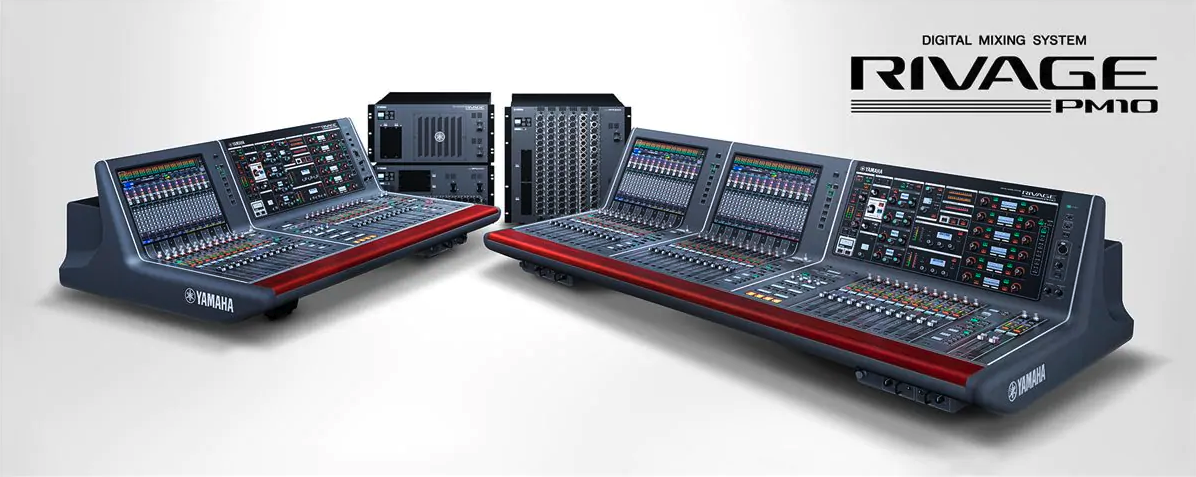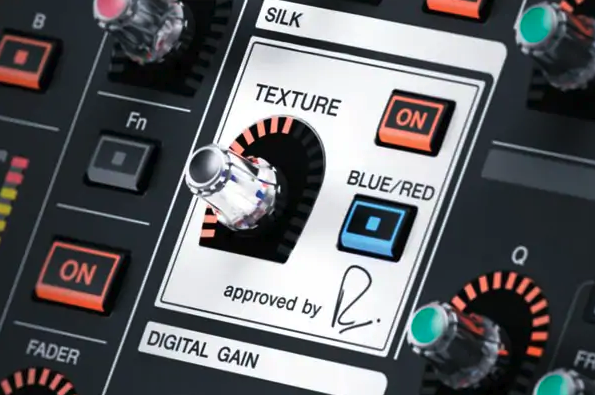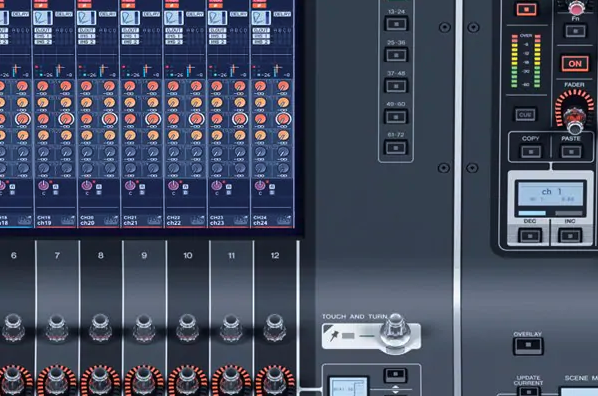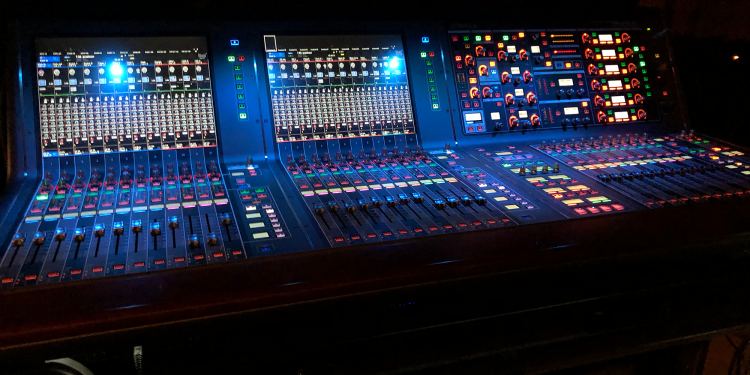Brown Note Productions has added the RIVAGE PM10 Soundboard from Yamaha to our inventory of audio consoles. Please read below for an in-depth look into the technical specifications of this powerhouse of a sound board.
More information HERE
- Concept | Sound
Designed and Refined for Sonic Perfection
The ideal starting point for sonic creativity is pure, natural reproduction. That concept is so ingrained in the Yamaha approach to mixer design that it has become an overarching philosophy. The sound being produced on stage must be accurately captured. Only then can it be effectively colored for the desired creative impact. Of course that same philosophy is uncompromisingly expressed in the RIVAGE PM10.
The foundation is a newly developed Hybrid Microphone Preamplifier design with an analog section that represents the Yamaha Natural Sound concept in its most advanced form. In the digital stage, evolved Yamaha VCM digital modeling technology recreates the characteristics of Rupert Neve Designs transformer circuitry and acclaimed SILK processing to achieve an extraordinarily musical, spacious sound. The channel EQ and dynamics have been significantly upgraded as well, offering expanded capability for expressive sonic control.
Internal plug-ins that support imaginative sound engineering have also taken a large evolutionary leap forward. Particular effort has been focused on collaborations with other manufacturers that are already receiving accolades. In addition to new VCM models of acclaimed EQ and compressor units from the 70’s and 80’s that have been jointly developed with Rupert Neve Designs, our first collaboration with TC Electronic has resulted in the inclusion of two exceptional reverb processors, and an Eventide Harmonizer is currently under development. An extensive selection of plug-ins, including popular types from previous Yamaha digital consoles, gives engineers the tools they need to create the perfect sound for every situation.
Everything is aimed at reproducing and creating the most musical sound possible. The RIVAGE PM10 sound results from exhaustive research and design with one resolute purpose: to achieve the highest possible sonic quality.
- Concept | Operation
Designed and Refined for Sonic Perfection
The ideal starting point for sonic creativity is pure, natural reproduction. That concept is so ingrained in the Yamaha approach to mixer design that it has become an overarching philosophy. The sound being produced on stage must be accurately captured. Only then can it be effectively colored for the desired creative impact. Of course that same philosophy is uncompromisingly expressed in the RIVAGE PM10.
The foundation is a newly developed Hybrid Microphone Preamplifier design with an analog section that represents the Yamaha Natural Sound concept in its most advanced form. In the digital stage, evolved Yamaha VCM digital modeling technology recreates the characteristics of Rupert Neve Designs transformer circuitry and acclaimed SILK processing to achieve an extraordinarily musical, spacious sound. The channel EQ and dynamics have been significantly upgraded as well, offering expanded capability for expressive sonic control.
Internal plug-ins that support imaginative sound engineering have also taken a large evolutionary leap forward. Particular effort has been focused on collaborations with other manufacturers that are already receiving accolades. In addition to new VCM models of acclaimed EQ and compressor units from the 70’s and 80’s that have been jointly developed with Rupert Neve Designs, our first collaboration with TC Electronic has resulted in the inclusion of two exceptional reverb processors, and an Eventide Harmonizer is currently under development. An extensive selection of plug-ins, including popular types from previous Yamaha digital consoles, gives engineers the tools they need to create the perfect sound for every situation.
Everything is aimed at reproducing and creating the most musical sound possible. The RIVAGE PM10 sound results from exhaustive research and design with one resolute purpose: to achieve the highest possible sonic quality.

Polished Operation Offers Confidence and Comfort
It is the sound engineer’s job to deliver the performance from stage to audience in the best possible way. Since the mixing console is the engineer’s primary tool, its operability is crucial, particularly in today’s rapidly evolving live sound environment. The RIVAGE PM10 system features a Hybrid Operation Style that takes the most highly valued aspects of Yamaha digital mixing consoles to a new, refined level that gives engineers unprecedented expressive control.
Underpinning the system’s extraordinary operability is a full implementation of Yamaha’s acclaimed Selected Channel interface on the right side of the prominently raised control surface top panel, allowing all parameters of the channel selected to be directly and intuitively controlled. The left side of the panel features two large LCD touch screens that provide logical continuity with the faders below, offering Centralogic style control of a large number of simultaneous channels. In addition to these two interface features, encoder position visibility has been enhanced, as have a number of other details that contribute to significantly improved operability overall.
Notable new features include Overlay and Isolate filters for enhanced scene memory operation, a Follow option for the send masters and direct outs, and more. There are also upgraded features for flexible live recording, dual monitor outputs, and a wealth of other details that add up to smooth operation and integration in a wider variety of working environments.
With operation and features designed to comprehensively support today’s live sound scene, RIVAGE PM10 allows engineers to focus on the sound and enjoy the creative process.
The RIVAGE PM10 system consists of a control surface, one or two DSP engines, up to eight I/O racks, and RY/HY cards. The system can be flexibly configured to suit applications of any scale or complexity.
- Features | Sound

Hybrid Microphone Preamplifiers: A Solid Foundation for Superior Sound
The Hybrid Microphone Preamplifiers at the input stage of the RIVAGE PM10 system provide the fundamental character for the system’s overall sound. One of the most important aspects of that character is the natural sound of the analog stage, consistent with the “Natural Sound” philosophy that Yamaha has championed all along. Parts selection, mechanical construction, circuit layout, power supply, and grounding can all affect the quality of analog circuitry, and have been painstakingly reviewed and refined in the RIVAGE PM10.
Even the slightest changes due to variations in individual parts have been rigorously evaluated and redressed. Final adjustments were made on the basis of aural evaluation by Yamaha experts as well as eminent outside engineers, resulting in a totally new design that is genuinely worthy of “flagship” status. The system’s ability to accurately capture the sound being produced on stage provides the best possible foundation for creative processing.
VCM Technology Models SILK Processing by Rupert Neve Designs

Another vital factor contributing to the superb sound of the Hybrid Microphone Preamplifier is its digital stage. The transformer circuitry and SILK processing incorporated in high-end analog devices from Rupert Neve Designs, designed by the legendary Rupert Neve himself, have been precisely modeled using original Yamaha VCM (Virtual Circuitry Modeling) technology. These extraordinary preamplifiers are available for use on all RIVAGE PM10 input channels.
VCM technology, which has already produced many highly regarded effects and plug-ins, was originally developed by Toshifumi Kunimoto (affectionately known as “Dr.K”) of K’s Lab at Yamaha. VCM precisely models every aspect of analog circuitry, right down to the characteristics of individual components such as resistors and capacitors as well as the circuit itself, fully recreating saturation and nonlinearities that are overlooked by conventional digital simulations. Aural evaluation and refinement by world-class engineers results in an exceptionally musical sound.
Rupert Neve himself is impressed with the capabilities of VCM technology, saying “at last a digital technology is able to create the superb sound that has previously only been available with analog circuitry.” Previously released in the form of plug-in versions of the Rupert Neve Designs Portico series processors, that same technology is now part of the RIVAGE PM10 Hybrid Microphone Preamplifiers.
The Rupert Neve Sound for All Engineers
The fact that recording engineers frequently use microphone preamps designed by Rupert Neve to give their sound a very appealing touch of natural compression and saturation is well known. SILK processing can take that seductive sonic beauty to new levels with added power and flair. Sounds that tend to get lost in the mix are given new life and luster with a lush analog-like core.
The SILK processing function provided in the RIVAGE PM10 Hybrid Microphone Preamplifiers offers two variations: “RED” for sparkling energy, and “BLUE” for solidity and power. There’s also a continuously variable “TEXTURE” knob that musically shapes the harmonic components to best suit the source. The benefits of SILK processing are also evident in the way channel EQ and reverb plug-ins affect the sound.
The fact that SILK can be used on all channels is a huge advantage. It can be applied only to specific channels to bring the corresponding parts to life within the mix, or to all channels to add depth and perspective to the mix overall.
The RIVAGE PM10 system makes the coveted Rupert Neve preamplifier sound available to a wider range of engineers who can put it to good creative use.
Channel EQ and Compression Refined to Unprecedented Levels
The RIVAGE PM10 channel EQ and dynamics have also been significantly updated and fine-tuned to match the innovations in the input section.
The input channels feature 4-band full parametric EQ, while the output channels are equipped with 8-band full parametric EQ, with 4 algorithm types that include newly developed variations. The “Precise” algorithm makes it easy to target and control specific EQ points, the “Aggressive” algorithm is designed for the most musical response, and the “Smooth” algorithm offers smooth, natural control. There’s also a “Legacy” algorithm that provides the familiar feel and response of the equalizers provided in industry-standard Yamaha digital consoles such as the PM1D and PM5D. The “Precise” algorithm includes Q parameters on the low and high shelving filters that allow filter overshoot to be flexibly controlled for added musical impact.
Two dynamics stages are provided, each functioning as a gate, two types of compressor, ducker, or de-esser as required. The two compressor types are “Legacy Comp,” inheriting the characteristics of the standard compressors in Yamaha digital consoles, and “Comp260,” which is a beautiful VCM model of a popular analog comp/limiter from the mid 70s. The latter accurately models the characteristics of the VCA circuit and RMS level detector used in the original device, with the effect of each parameter fine-tuned for optimum effect in live-sound applications. Presets that recreate the original fixed settings of this classic comp/limiter are also provided for convenience in situations that require the original sound.
In addition to the luxury of having these outstanding EQ and dynamics stages available for use on all channels, the RIVAGE PM10 system also provides two insert points with up to four plug-ins, GEQ units, PEQ units, and/or outboard devices in series being assignable to each insert point.
Plug-in Effects Include Rupert EQ/Comp, TC Electronic Reverb, and More
Processing quality has always been a major strength of Yamaha digital consoles. The comprehensive selection of plug-ins available for use in the CL and QL series Premium Rack and Effect Rack, including models of in-demand classics, are highly regarded features of those consoles. The RIVAGE PM10 system includes all of those effects seamlessly merged with several new additions for a total of 45 plug-ins. Processing power has been substantially increased, allowing up to 192 instances of complex plug-ins such as the Portico 5033 or Portico 5043 to be used simultaneously.
Of the new additions to the effect roster, four new VCM models resulting from recent collaborations with Rupert Neve Designs are particularly worthy of note. These are the “Rupert EQ 773” and “Rupert Comp 754” which are models of outboard devices from the 70s, and the more modern “Rupert EQ 810” and “Rupert Comp 830” from the 80s. All four models deliver the musical vintage outboard sound still favored by many engineers.
Collaboration with TC Electronic has also resulted in the inclusion of two new reverb plug-ins: the “VSS4HD” finest room simulation reverb that offers a multitude of reflection settings with musical-sounding reverb processing capabilities, and the “NonLin 2” plug-in that can function as an envelope-filtered gate reverb without requiring a trigger.
Yamaha and Eventide are currently working on the “H3000-LIVE” harmonizer to be introduced with a future update. “H3000-LIVE” is an accurate reproduction of the H3000 Ultra Harmonizer algorithm with an interface streamlined for live sound use.
The RIVAGE PM10 plug-ins are not just showy bells and whistles. They are carefully chosen, practical effects that can be invaluable for creative processing in real-world live sound applications.
- Features | Operation

The Complete Yamaha Selected Channel Interface
Yamaha has always focused on operability in digital live sound consoles, sparing no effort in providing an interface that engineers coming from analog consoles can operate intuitively, while at the same time maximizing the benefits of digital technology and features. The RIVAGE PM10 system takes that concept to a new level, extending an already familiar and highly rated interface for even greater efficiency and ease in achieving the desired sound.
A key element of that interface is Yamaha’s industry-standard Selected Channel concept, providing direct access to parameters of any channel selected via its SEL key. The Selected Channel section of the RIVAGE PM10 inherits the full-featured configuration of the legendary PM1D digital console, providing direct, fast access to all channel parameters. Encoders, buttons, and indicators are provided in a comprehensive layout that makes maximum use of the available panel space, for comfortable operation in any environment or mixing situation.
Touch Screen and Fader Strip Merge for Intuitive Control

The RIVAGE PM10 control surface features three groups of 12 faders to which channels can be assigned as required. The two leftmost fader groups work with large touch panel displays in the top panel, providing an enhanced version of the Centralogic operating environment. The channel strips extend vertically and virtually seamlessly into the touch panel displays, for lucid, logical control.
In the RIVAGE PM10 system this allows channels to be conveniently managed in 12 channel groups. It even facilitates 2-man operation, with different operators handling the left and right groups. Features like headphone jacks on both ends of the front panel and pull-out headphone hangers make it clear that Yamaha is serious about giving sound engineers the most comfortable working environment possible.
A Monitor Section to Match Any Job
The monitoring needs of live sound reinforcement can vary considerably from job to job, so a flexible monitor system is essential. The RIVAGE PM10 system has two monitor outputs plus Cue busses, and up to eight combinations of monitor sources can be stored for instant recall. Of course output level is independently adjustable for each. The monitor section also offers dedicated delays, plus 8-band parametric EQ. An insert point prior to the EQ stage allows plug-ins to be used in the monitor section as well. The carefully planned and flexible features provided in the RIVAGE PM10 monitor section make it easy to adapt to any monitoring situation.
Convenience Is In the Details
The main encoders on the RIVAGE PM10 panel are surrounded by horseshoe shaped rings of indicators that show the current settings. The horseshoe ring shape is designed to provide optimum visibility when, for example, the encoders are viewed from below, which is often the case with the multifunction encoders at the top of the fader strips. The unique shape ensures that indicators near the 12 o’clock position are not hidden behind the encoder knob.
The fader knob shape, developed through years of designing and refining mixer interfaces, is another important feature. The fader knobs are contoured so that positive, comfortable control is possible no matter where your finger is placed on the knob. This is a feature that can only be truly appreciated through first-hand experience.
A small lamp is built into the front of the panel below the arm rest, specifically to illuminate a keyboard and mouse that may be placed there. It’s a small detail, but one of many that contribute to significantly improved overall operation.
Overall, the console is designed with the touch panel displays and Selected Channel section on a prominently raised upper panel that offers optimum visibility from the engineer’s position as well as easy access to all controls, plus the ability to keep an eye on both the stage and console at the same time. The touch screens are also located within easy reach for effortless access.
- Features | Enhanced Functionality
Isolate, for Enhanced Scene Recall Versatility
A major merit offered by most modern digital consoles is scene memory. Since different engineers often have widely varying mixing styles and views on how scene memory should be used, it is a feature that must be implemented in the most flexible way possible.
The RIVAGE PM10 system provides a variety of ways to “filter” scene memory recall operations. Focus recall, a feature that is already familiar to Yamaha console users, makes it possible to specify the types of data to be recalled. Recall Safe works the other way, preventing specified types of data from being recalled. Now the “Isolate” filter makes it possible to specify entire channel modules, including EQ and dynamics libraries, etc., that will be protected from recall operations. This means that even if certain parameters of a channel are protected by Recall Safe, for example, you can instantly isolate and protect the entire channel from recall without altering the Recall Safe settings. This is a feature that will be of great value in situations where scene memory is used heavily.
Overlay Filter for Rapid Response to Sudden Changes
The Overlay filter is another new feature that can notably extend the usefulness of the scene memory. This filter can be “overlaid” on a current mix to apply offsets to the fader levels and mix/matrix send levels independently from scene recall. An example of how this might be useful is when an unplanned performer change occurs, requiring adjustments to the level of the corresponding channel. Using the Overlay filter it becomes possible to make a temporary, relative level change to that channel and then instantly revert to the original level. The Overlay filter will prove its value in situations that require sudden changes plus the ability to easily revert to the original settings.
Two Convenient Approaches to Live Recording
Professional quality live recording capability is becoming an essential feature in live sound consoles. In addition to convenient 2-track recording to a USB flash drive, the RIVAGE PM10 system supports multitrack recording via an optional Dante audio network to meet the widest possible range of serious recording requirements.
The 2-track USB flash drive recorder function directly records the output of the STEREO or MIX bus to the flash drive. Background music or sound effects recorded on the flash drive can also be assigned to any input channel for playback. Sample rate conversion is provided for both input and output, so the recorder function can be used without having to think about the system sampling rate. Data can be recorded to or played back from WAV or MP3 files, as required.
Multitrack recordings can be made to a computer based DAW via a Dante audio network implemented with the optional HY144-D card. High-resolution recording of up to 128 channels (input and output) at 96 kHz is possible if the computer is equipped with a Dante Accelerator PCIe audio interface card. With Dante Virtual Soundcard the maximum in/out track count is 64.
Multitrack recordings of rehearsals made in this way can be used for “virtual sound checks” when the performers aren’t available. Input patching for all required channels can be switched in one operation for both recording and virtual sound checks. Recorder playback and stage input can even be smoothly combined when needed.


